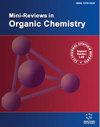2-氨基喹啉的化学:合成、反应性和生物活性(第三部分)。
IF 1.9
4区 化学
Q2 CHEMISTRY, ORGANIC
引用次数: 0
摘要
本文综述了n -芳基乙酰酰胺的Vilsmeier-Haack甲酰化反应制备2-氯喹啉-3-醛衍生物,并将其作为合成2-氨基喹啉-3-醛的关键中间体。通过Claisen-Schmidt缩合反应、1,3 -偶极环加成反应、一锅多组分反应和还原胺化反应等化学反应解释了2-氨基喹啉类化合物的合成。本文章由计算机程序翻译,如有差异,请以英文原文为准。
Chemistry of 2-Aminoquinolines: Synthesis, Reactivity, and Biological Activities (Part III).
This review described the preparation of 2-chloroquinoline-3-carbaldehyde derivatives through Vilsmeier-Haack formylation of N-arylacetamides and the use of them as a key intermediate for the preparation of 2-aminoquinoline-3-carbaldehydes. The synthesis of the 2-aminoquinolines was explained through the following chemical reactions: Claisen-Schmidt condensation, 1, 3-dipolar cycloaddition, one-pot multicomponent reactions (MCRs), and reductive amination.
求助全文
通过发布文献求助,成功后即可免费获取论文全文。
去求助
来源期刊
CiteScore
4.50
自引率
4.30%
发文量
116
审稿时长
>12 weeks
期刊介绍:
Mini-Reviews in Organic Chemistry is a peer reviewed journal which publishes original reviews on all areas of organic chemistry including organic synthesis, bioorganic and medicinal chemistry, natural product chemistry, molecular recognition, and physical organic chemistry. The emphasis will be on publishing quality papers very rapidly, without any charges.
The journal encourages submission of reviews on emerging fields of organic chemistry including:
Bioorganic Chemistry
Carbohydrate Chemistry
Chemical Biology
Chemical Process Research
Computational Organic Chemistry
Development of Synthetic Methodologies
Functional Organic Materials
Heterocyclic Chemistry
Macromolecular Chemistry
Natural Products Isolation And Synthesis
New Synthetic Methodology
Organic Reactions
Organocatalysis
Organometallic Chemistry
Theoretical Organic Chemistry
Polymer Chemistry
Stereochemistry
Structural Investigations
Supramolecular Chemistry

 求助内容:
求助内容: 应助结果提醒方式:
应助结果提醒方式:


